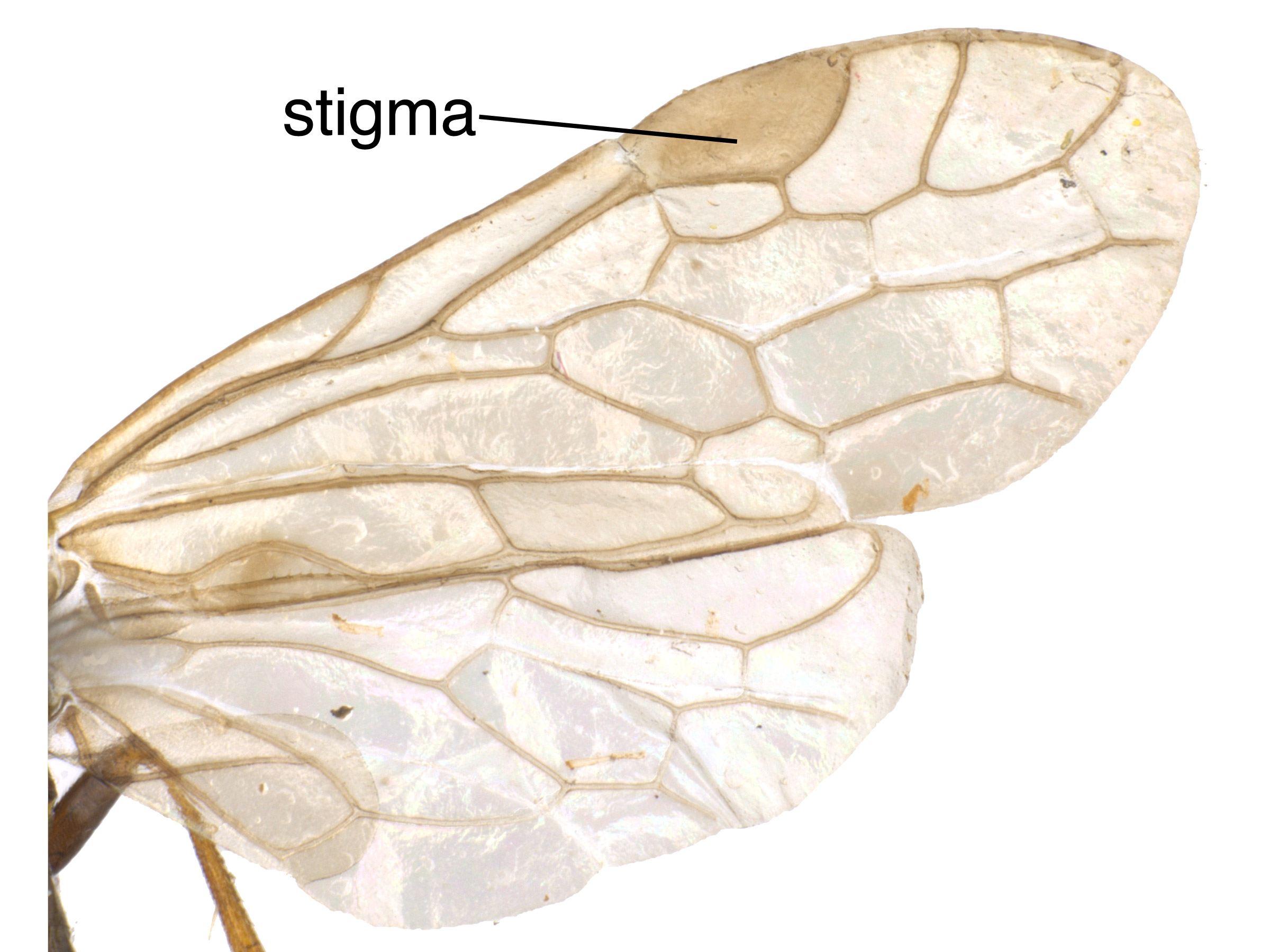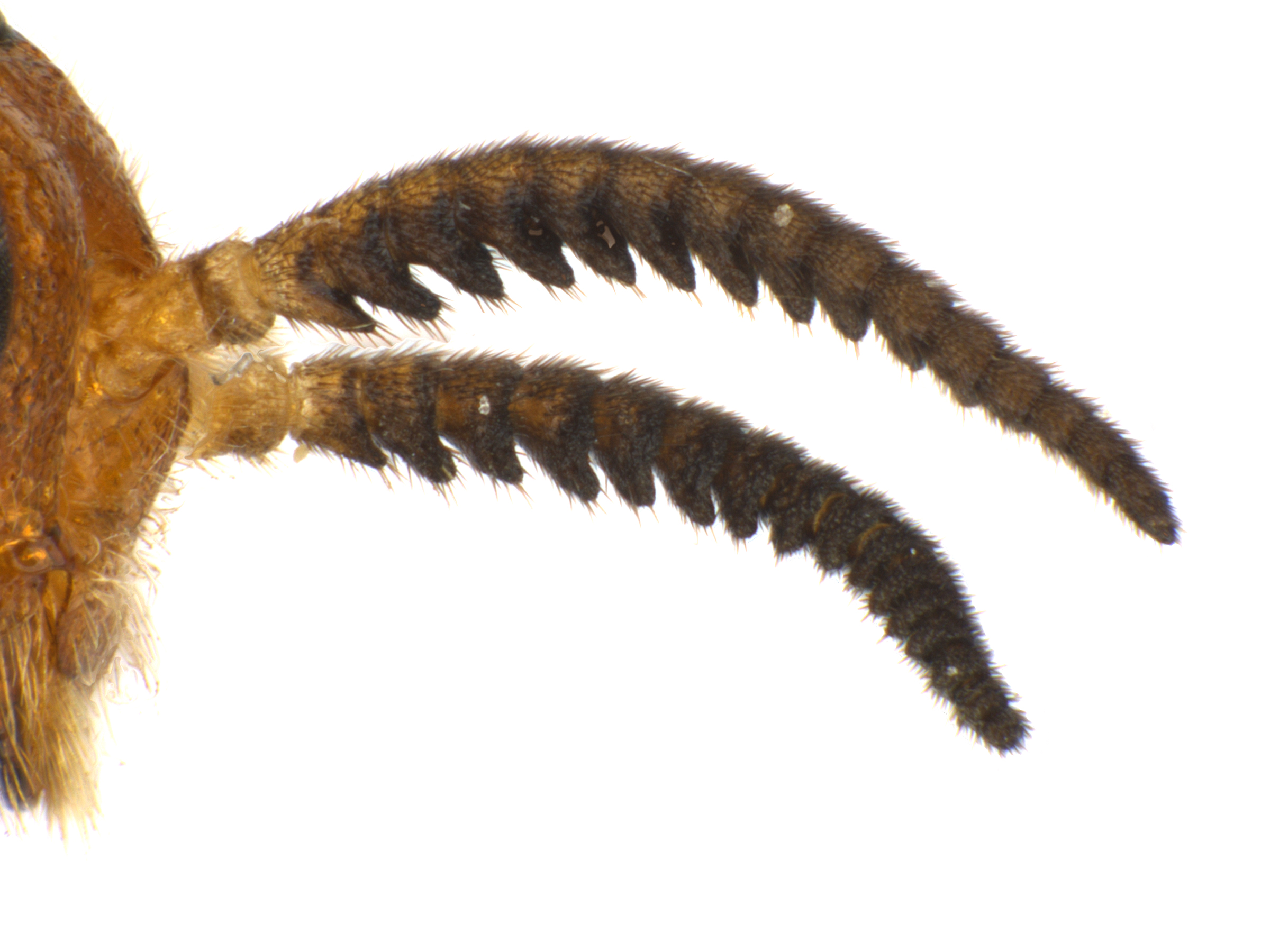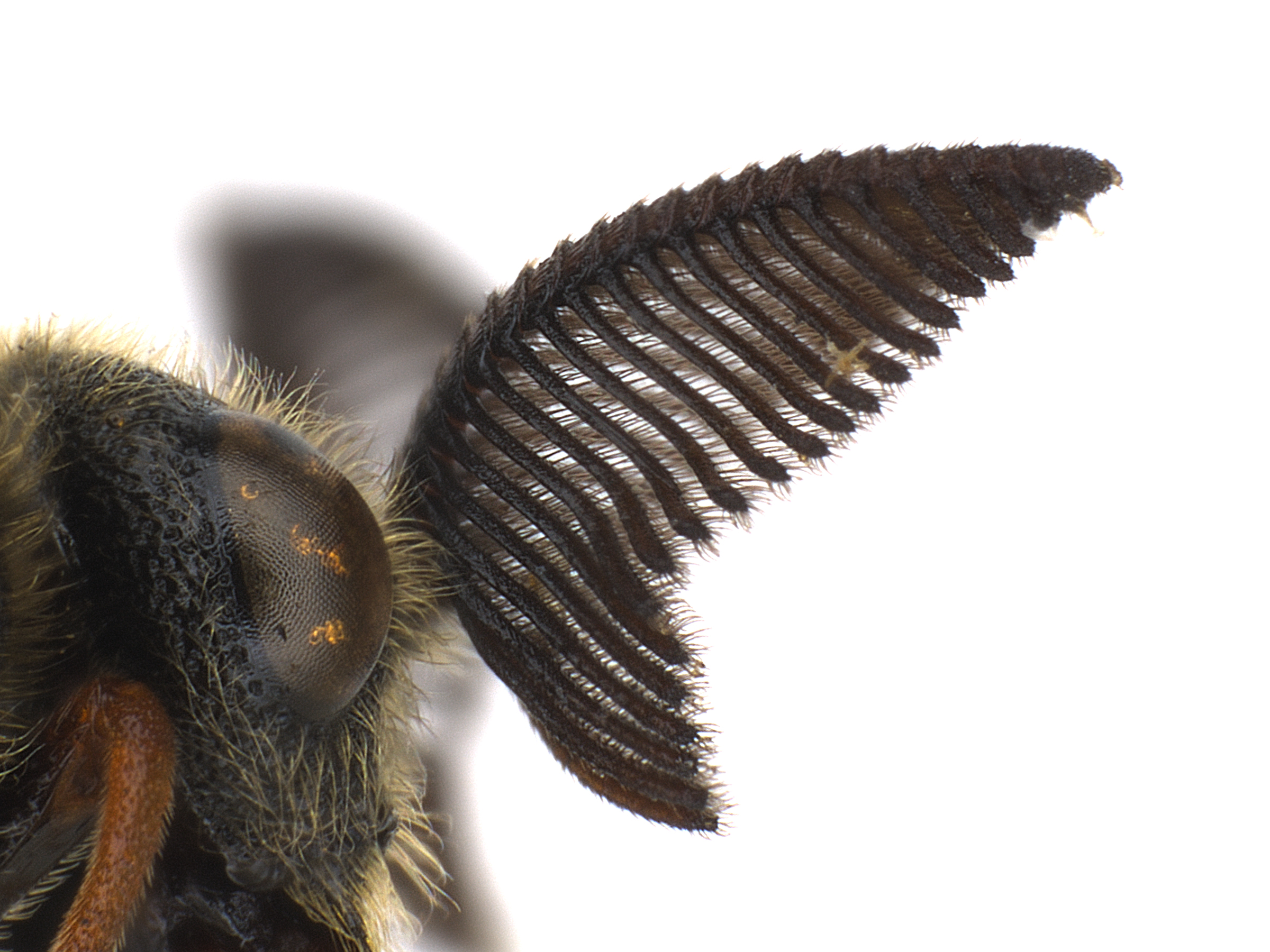Family: Tenthredinidae
Family common name: common sawflies
Subfamily: Nematinae
Tribe: Cladiini
Genus: Cladius Illiger, 1807
Subgenera: Cladius, Priophorus, Trichiocampus
The Tenthredinidae are the most species-rich family and are found throughout the world, in all continents but Antarctica. They are known as the “common sawflies.” They can generally be recognized by a cylindrical body and long, segmented antennaeantenna:
the sensory organ emerging from the front of the head, usually between the compound eyes and above the clypeus; includes the flagellum, scape and pedicel
 . Otherwise, they come in a variety of colors, sizes, and forms (Goulet 1992Goulet 1992:
. Otherwise, they come in a variety of colors, sizes, and forms (Goulet 1992Goulet 1992:
Goulet H. 1992. The genera and subgenera of the sawflies of Canada and Alaska: Hymenoptera. Symphyta. The insects and arachnids of Canada. Part 20. Agriculture Canada Publication.).
Nematinae is the second-largest subfamily of Tenthredinidae, with over 1,250 species (Prous et al. 2014Prous et al. 2014:
Prous M, Blank SM, Goulet H, Heibo E, Liston A, Malm T, Nyman T, Schmidt S, Smith DR, Varing;rdal H, Viitasaari M, Vikberg V, and Taeger A. 2014. The genera of Nematinae (Hymenoptera, Tenthredinidae). Journal of Hymenoptera Research 40: 1-69. " target="_blank">https://doi.org/10.3897/JHR.40.7442). They are most diverse in northern Eurasia and North America; only a few species occur in the Southern Hemisphere. Nematinae sawflies have a variety of feeding habits including external leaf feeding, leaf mining, and gall forming, and feed on a variety of hosts (Smith 2003bSmith 2003b:
Smith DR. 2003b. A Synopsis of the sawflies (Hymenoptera: Symphyta) of America south of the United States: Tenthredinidae (Nematinae, Heterarthrinae, Tenthredininae). Transactions of the American Entomological Society 129 (1): 1-45.).
The Nematinae have been subject to numerous revisions in recent years. As of 2021, there are no comprehensive keys to many of the North American species of Nematinae (Prous et al. 2014Prous et al. 2014:
Prous M, Blank SM, Goulet H, Heibo E, Liston A, Malm T, Nyman T, Schmidt S, Smith DR, Varing;rdal H, Viitasaari M, Vikberg V, and Taeger A. 2014. The genera of Nematinae (Hymenoptera, Tenthredinidae). Journal of Hymenoptera Research 40: 1-69. " target="_blank">https://doi.org/10.3897/JHR.40.7442). Because of changing taxonomy and extreme variability in morphology, identifying genera and species in the Nematinae may be more challenging than in other subfamilies of Tenthredindae. For this reason, knowing the host or behaviors of a specimen can be extremely helpful for identification within this subfamily.
Cladius are generally entirely black, small, and inconspicuous (Rohwer and Middleton 1922Rohwer and Middleton 1922:
Rohwer SA and Middleton W. 1922. North American sawflies of the subfamily Cladiinae with notes on habits and descriptions of larvae. Proccedings of the National Museum 60 (2396): 1-46.). LarvaeLarva:
the immature stage of holometabolous insects
 , however, are distinctly hairy, and many are common pests in North America (Smith 1974bSmith 1974b:
, however, are distinctly hairy, and many are common pests in North America (Smith 1974bSmith 1974b:
Smith DR. 1974b. Conifer sawflies, Diprionidae: Key to North American genera, checklist of world species, and a new species from Mexico (Hymenoptera). Proceedings of the Entomological Society of Washington 76: 409-418.). The taxonomy of the genus Cladius is the subject of some debate, with many authors treating current subgenera Cladius, Priophorus, and Trichiocampus as separate genera (Vikberg 2013Vikberg 2013:
Vikberg V. 2013. Hemp sawfly found in European Russia (Hymenoptera: Tenthredinidae, Nematinae, Cladiini). Entomologica Fennica 24: 172-178.).
There are 46 described species worldwide. Eight species occur in North America (Taeger et al. 2018Taeger et al. 2018:
Taeger A, Liston AD, Prous M, Groll EK, Gehroldt T, and Blank SM. 2018. ECatSymmdash;Electronic World Catalog of Symphyta (Insecta, Hymenoptera). Program version 5.0 (19 Dec 2018), data version 40 (23 Sep 2018). Senckenberg Deutsches Entomologisches Institut (SDEI), Muuml;ncheberg. https://sdei.de/ecatsym/ Accessed: 28 Jan 2020.).
A key to North American species (as Cladius, Priophorus and Trichiocampus) is included in Smith 1974bSmith 1974b:
Smith DR. 1974b. Conifer sawflies, Diprionidae: Key to North American genera, checklist of world species, and a new species from Mexico (Hymenoptera). Proceedings of the Entomological Society of Washington 76: 409-418..
Subfamily characters
 (Goulet 1992Goulet 1992:
(Goulet 1992Goulet 1992:Genus characters
 and pedicelpedicel:
and pedicelpedicel: combined length less than half the length of the first flagellomereflagellomere:
combined length less than half the length of the first flagellomereflagellomere: (Goulet 1992Goulet 1992:
(Goulet 1992Goulet 1992: thin and thread-like (Goulet 1992Goulet 1992:
thin and thread-like (Goulet 1992Goulet 1992: with long hairs and variable in form: thread-like, serrateserrate:
with long hairs and variable in form: thread-like, serrateserrate: or pectinatepectinate:
or pectinatepectinate: (Goulet 1992Goulet 1992:
(Goulet 1992Goulet 1992: cellcell:
cellcell: M present (Smith 1974bSmith 1974b:
M present (Smith 1974bSmith 1974b: veins M and Rs+M meeting or closely separated on veinvein:
veins M and Rs+M meeting or closely separated on veinvein: Sc+R (Smith 1974bSmith 1974b:
Sc+R (Smith 1974bSmith 1974b: vein 2m-cu meeting cellcell:
vein 2m-cu meeting cellcell: 2Rs (or cellcell:
2Rs (or cellcell: 1Rs very near to veinvein:
1Rs very near to veinvein: 2r-m in a few aberrant specimens) (Goulet 1992Goulet 1992:
2r-m in a few aberrant specimens) (Goulet 1992Goulet 1992: vein 2A+3A gradually curved up and meeting veinvein:
vein 2A+3A gradually curved up and meeting veinvein: 1A, thus basalbasal:
1A, thus basalbasal:Cladius may be confused with other genera in the subfamily Nematinae — especially those that include several entirely black species such as Pristiphora — but can be distinguished from most others by the closely spaced fore wingfore wing:
the anterior wing of each pair of wings; usually the largest wing of the pair
 veins M and Rs+M on veinvein:
veins M and Rs+M on veinvein:
a tube-like, often darkened, structure on the wings
 R. Cladius difformis males are easily recognized by pectinatepectinate:
R. Cladius difformis males are easily recognized by pectinatepectinate:
comb-like in form
 antennaeantenna:
antennaeantenna:
the sensory organ emerging from the front of the head, usually between the compound eyes and above the clypeus; includes the flagellum, scape and pedicel
 (Goulet 1992Goulet 1992:
(Goulet 1992Goulet 1992:
Goulet H. 1992. The genera and subgenera of the sawflies of Canada and Alaska: Hymenoptera. Symphyta. The insects and arachnids of Canada. Part 20. Agriculture Canada Publication.).
The hemp sawfly, Cladius cannabis, is a pest on cultivated Cannabis sativa in China and has recently spread into western Russia. The larvaelarva:
the immature stage of holometabolous insects
 feed heavily on the foliage and skeletonize leaves. The species is bivoltinebivoltine:
feed heavily on the foliage and skeletonize leaves. The species is bivoltinebivoltine:
describing a life cycle with two generations per calendar year
in its known range, and can reproduce without the presence of males (Vikberg 2013Vikberg 2013:
Vikberg V. 2013. Hemp sawfly found in European Russia (Hymenoptera: Tenthredinidae, Nematinae, Cladiini). Entomologica Fennica 24: 172-178.).
Cladius brullei (as Priophorus morio) was introduced to Hawaii as a biocontrol agent to control wild blackberry (Davis and Krauss 1967Davis and Krauss 1967:
Davis CJ and Krauss NLH. 1967. Recent introductions for biological control in Hawaii-XII. Proceedings of the Hawaiian Entomological Society 19 (3): 375-380., Davis and Chong 1969Davis and Chong 1969:
Davis CJ and Chong M. 1969. Recent introductions for biological control in Hawaii-XIV. Proceedings of the Hawaiian Entomological Society 20 (2): 317-322., Smith 1974bSmith 1974b:
Smith DR. 1974b. Conifer sawflies, Diprionidae: Key to North American genera, checklist of world species, and a new species from Mexico (Hymenoptera). Proceedings of the Entomological Society of Washington 76: 409-418.). Conversely, it was accidently introduced to New Zealand and Australia and is a damaging pest of raspberries there (Callan 1978Callan 1978:
Callan EM. 1978. Biological notes on the introduced sawfly Priophorus morio (Lepeletier) (Hymenoptera: Tenthredinidae) in Australia. Journal of Australian Entomological Society 17: 23-24.). It has also been introduced into South America (Lucía et al. 2007).
Cladius difformis, also known as the bristly rose slug, is a pest of roses cited as the “most common defoliatordefoliator:
an insect that defoliates
of roses in the eastern states” (Rohwer and Middleton 1922Rohwer and Middleton 1922:
Rohwer SA and Middleton W. 1922. North American sawflies of the subfamily Cladiinae with notes on habits and descriptions of larvae. Proccedings of the National Museum 60 (2396): 1-46.). Females oviposit in rows into the petiolepetiole:
stalk or stem; used to describe basal vein stalk in wing OR basal stalk of a leaf.
of a leaf. The larvaelarva:
the immature stage of holometabolous insects
 , which are distinctively hairy, feed on the leaf tissue, leaving holes and blotches, eventually skeletonizing the leaf. At maturity, the larvaelarva:
, which are distinctively hairy, feed on the leaf tissue, leaving holes and blotches, eventually skeletonizing the leaf. At maturity, the larvaelarva:
the immature stage of holometabolous insects
 spin thin, papery cocoons to pupate or overwinter. In the summer, the life cycle only takes about 30 days to complete, and the species can complete 4–6 generations per year, so the damage from repeated feeding can be severe (Smith 1974bSmith 1974b:
spin thin, papery cocoons to pupate or overwinter. In the summer, the life cycle only takes about 30 days to complete, and the species can complete 4–6 generations per year, so the damage from repeated feeding can be severe (Smith 1974bSmith 1974b:
Smith DR. 1974b. Conifer sawflies, Diprionidae: Key to North American genera, checklist of world species, and a new species from Mexico (Hymenoptera). Proceedings of the Entomological Society of Washington 76: 409-418.).
Cladius grandis, known as the poplar sawfly, is a pest on several species of Populus. It is known to defoliatedefoliate:
to elimate a sizeable portion of the foliage of a tree, either by feeding on the leaves or otherwise causing a severe decreae in photosynthetic ability
entire trees when larvaelarva:
the immature stage of holometabolous insects
 are present in high abundance. Interestingly, larvaelarva:
are present in high abundance. Interestingly, larvaelarva:
the immature stage of holometabolous insects
 will search for pupation or overwintering locations and will sometimes end up inside homes and buildings. One record in Victoria, British Columbia claims thousands of larvaelarva:
will search for pupation or overwintering locations and will sometimes end up inside homes and buildings. One record in Victoria, British Columbia claims thousands of larvaelarva:
the immature stage of holometabolous insects
 were climbing the walls of a house behind a poplar grove and had to be removed “by the shovelful” (Downes 1925Downes 1925:
were climbing the walls of a house behind a poplar grove and had to be removed “by the shovelful” (Downes 1925Downes 1925:
Downes W. 1925. The poplar sawfly ( Trichiocampus viminalis (Falleacute;n)). Proceedings of the Entomological Society of British Columbia 22: 26-32.).
In North America, Cladius feeds on species of Rosa (rose), Betula (birch), Salix (willow), Rubus (blackberry), Alnus (alder), Crataegus (hawthorn), Prunus (cherry/plum), and Populus (poplar/cottonwood) (Smith 1974bSmith 1974b:
Smith DR. 1974b. Conifer sawflies, Diprionidae: Key to North American genera, checklist of world species, and a new species from Mexico (Hymenoptera). Proceedings of the Entomological Society of Washington 76: 409-418.).
Females oviposit into leaves or leaf petioles in short rows. Larvaelarva:
the immature stage of holometabolous insects
 feed externally, then pupate or overwinter in the soil. All studied species are multivoltinemultivoltine:
feed externally, then pupate or overwinter in the soil. All studied species are multivoltinemultivoltine:
describing a life cycle with many generations per calendar year
(Smith 1974bSmith 1974b:
Smith DR. 1974b. Conifer sawflies, Diprionidae: Key to North American genera, checklist of world species, and a new species from Mexico (Hymenoptera). Proceedings of the Entomological Society of Washington 76: 409-418.).
Larvaelarva:
the immature stage of holometabolous insects
 of Cladius are generally hairy and are capable of producing glandular secretions for chemical defense (Boevé et al. 2000Boevé et al. 2000:
of Cladius are generally hairy and are capable of producing glandular secretions for chemical defense (Boevé et al. 2000Boevé et al. 2000:
Boevé JL, Heilporn S, Dettner K, and Francke W. 2000. The secretion of the ventral glands in Cladius, Priophorus, and Trichiocampus sawfly larvae. Biochemical Systematics and Ecology 28: 857–864. https://doi.org//10.1016/S0305-1978(00)00008-9). Species in the subgenera Cladius and Priophorus are cryptically colored and solitary, while those in the subgenus Trichiocampus are brightly colored, gregariousgregarious:
describing insects in large groups or aggregations
, and unpalatable to birds — a combination of larval traits which likely represents a suite of defensive mechanisms against predators (Boevé et al. 2000Boevé et al. 2000:
Boevé JL, Heilporn S, Dettner K, and Francke W. 2000. The secretion of the ventral glands in Cladius, Priophorus, and Trichiocampus sawfly larvae. Biochemical Systematics and Ecology 28: 857–864. https://doi.org//10.1016/S0305-1978(00)00008-9).
World: The genus is known from North America, throughout Europe, Turkey, Iran, China, and Vietnam (Wei 2000Wei 2000:
Wei M. 2000. Revision of Cladiini (Hymenoptera: Tenthredinomorpha: Nematidae) from China (I): Notes on Cladiini and Driocampus Zhang with revision of Cladius Illiger from China. Journal of Jishou University (Natural Science Edition) 22 (3): 34-39., Khosravi et al. 2014Khosravi et al. 2014:
Khosravi R, Jalali Sendi J, Ebrahimi E, and Blank SM. 2014. First record of Cladius (Priophorus) rufipes (Hym.: Tenthredinidae) from Iran. Journal of Entomological Society of Iran 33 (4): 73-75., Kato and Shinohara 2018Kato and Shinohara 2018:
Kato Y and Shinohara A. 2018. A new record of the genus Cladius Illiger (Hymenoptera: Tenthredinidae) from Vietnam. Japanese Journal of Systematic Entomology 24 (1): 19-20.). Cladius brullei was introduced to New Zealand in 1936 and Australia in 1959, where it is now established (Callan 1978Callan 1978:
Callan EM. 1978. Biological notes on the introduced sawfly Priophorus morio (Lepeletier) (Hymenoptera: Tenthredinidae) in Australia. Journal of Australian Entomological Society 17: 23-24.), and to Chile in 2002 and Argentina in 2007, where the status is not known (Lucía et al. 2007).
North America: Cladius occurs through the northern United States and Canada, as far north as Alaska and Yukon (Smith 1974bSmith 1974b:
Smith DR. 1974b. Conifer sawflies, Diprionidae: Key to North American genera, checklist of world species, and a new species from Mexico (Hymenoptera). Proceedings of the Entomological Society of Washington 76: 409-418., GBIF). Cladius difformis is recorded as adventive in Hawaii, but may not be established as no new collections have been made since 1976 (Nakahara 1979Nakahara 1979:
Nakahara L. 1979. Cladius difformis . Proceedings of the Hawaiian Entomological Society 8 (1): 16-17., Janis Matsunaga pers. comm.). Cladius brullei was introduced to Hawaii in 1966 and 1968 and is now established on Hawaii Island (Davis and Krauss 1967Davis and Krauss 1967:
Davis CJ and Krauss NLH. 1967. Recent introductions for biological control in Hawaii-XII. Proceedings of the Hawaiian Entomological Society 19 (3): 375-380., Davis and Chong 1969Davis and Chong 1969:
Davis CJ and Chong M. 1969. Recent introductions for biological control in Hawaii-XIV. Proceedings of the Hawaiian Entomological Society 20 (2): 317-322., Janis Matsunaga pers. comm.).
Map data from: GBIF.org (29 October 2019) GBIF Occurrence Download Cladius
Details about data used for maps can be found here.